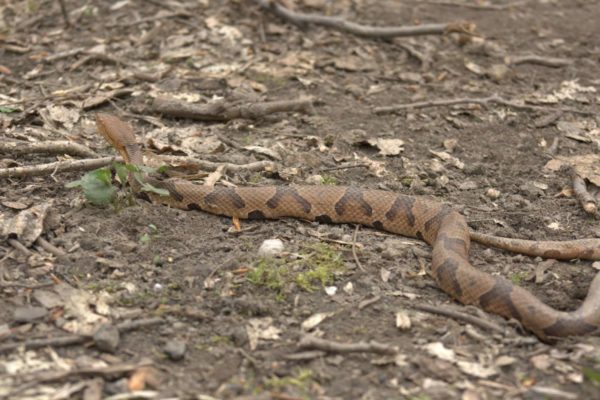If it seems like you’ve been seeing more reports of snakes around Arlington on local listservs, you’re not alone. Arlington County officials said there’s been a noticeable uptick in reported copperhead snake sightings.
Alonso Abugattas, the county’s natural resources manager, said there has been an increase in copperhead snake sightings but that the exact numbers are hard to track down because he, Arlington’s nature centers, and animal control all get and respond to calls about snakes.
“This past year I have gotten more,” Abugattas said, “but I expect there’s been more because more people are outside.”
Abugattas said with coronavirus keeping people at home rather than in their offices, the increase in calls may have something to do with people exploring their local parks during the day, when copperhead snakes are more active.
“Parks have had a 200% increased use because people are at home and bored,” Abugattas said. “I think more than anything else, people are more aware of them.”
The local emergency room is also seeing evidence of rising encounters between snakes and humans.
“We’ve had a few patients with copperhead bites recently,” Mike Silverman, head of the emergency department at Virginia Hospital Center, wrote last Friday. “As someone who trained and worked for a long time in Baltimore City, it’s seems so weird to see snake bites in what’s otherwise an urban area but they are definitely in Arlington.”
He encouraged anyone suffering from a snakebite to get a photo of the snake.
“Pictures of dead snakes are great,” Silverman wrote. “Please don’t feel the need to bring the snake into the ER, even if it’s dead, though it does add a little excitement to the shift.”
The copperhead is one of only three venomous snakes found in Virginia and the only one found in Arlington County. Ken Rosenthal, park naturalist at Gulf Branch Nature Center (3608 N. Military Road), said in a presentation last Thursday that they are most likely to be found in Gulf Branch and along the rocky, forested hillsides along the Potomac River.
Despite being venomous, Abugattas said there have only been one or two cases nationwide of copperheads killing humans, and even those had other factors. Neither of them, Abugattas said, were in Virginia.
“It is, for the most part, a very timid snake,” Abugattas said. “Even when they do bite, about one-third of the bites are dry bites — a warning.”
Abugattas said most snakes do their best not to bite, which could also put the snake in a dangerous situation. Copperheads will release a musk or make noise to try to keep larger animals — like humans — away.
Copperheads emerge from brumation in the spring, which accounts for some seasonal increase in sightings. In both hunting and nesting, Rosenthal said they don’t shy away from human habitation and are very good at camouflage, which can lead to frightening encounters between humans and copperheads.
“On a night like tonight when it’s humid and warm, I will walk out with my cell phone flashlight on when I walk out to my car,” Rosenthal said, “just to make sure the sticks are sticks and the shadows are shadows.”
Despite the increase in calls, it’s unclear whether the local copperhead population is actually increasing. Rosenthal said there isn’t enough data to say one way or the other.
“Last year, I heard that a lot of people were seeing them,” Rosenthal said. “The population is healthy, but I can’t say if it’s more or less… I don’t know about the numbers, but they’re out there. It’s a good ecosystem.”
Abugattas is a member of the Virginia Herpetological Society and said there hasn’t been a noticeably large increase in statewide counts, but that the sightings are going up when people aren’t at work.
If anyone encounters a copperhead in the wild, Abugattas said the best thing to do is just to leave them be and go your separate ways. Relocating the animal may seem humane, but Abugattas said taking the snake to a new location often means the animal dies anyway.
“If it’s in your house, call animal control,” Abugattas said. “If there’s one in a stairwell or something, you can call Virginia Herpetological Society and they may move it. For any kind of animal though, when you move them, chances of survival are minimalized.”
Abugattas said copperheads are naturally timid, but oftentimes by the time animal control of Abugattas arrives at the scene the animal has been too riled up by humans to be calmed.
“Unfortunately, if it’s an outside scenario, they’ve been threatened so much and it’s hard to tell if they’re that way or if they’re just so scared,” Abugattas said. “By the time we get there, they’ve usually been harassed. But when we take care of them they’re remarkably timid and calm.”
Rosenthal said if you spot a snake, the alternating dark and light sequence of bands are the easiest way to identify the snake as a copperhead, with the bands narrowing towards the spine and widening towards the belly like saddlebags.
If any local resident is having snake problems, Rosenthal said one of the best things to do is examine the environment for small gaps and holes that make for inviting homes.
“There’s a lot of talk in the neighborhoods about copperheads and I know there’s a couple of sightings in the park,” Rosenthal said. “I think people get anxious about having a venomous snake in the area. I want to make sure snakes that aren’t venomous don’t get whacked because people think they’re copperheads, but also to protect and preserve copperheads. They’re a part of the ecosystem and it would be a shame to not have them here.”
Photo via Gulf Branch Nature Center/Facebook


